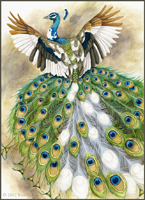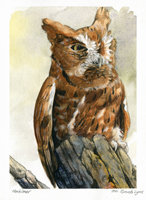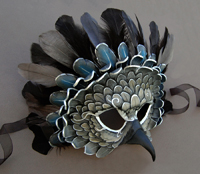For the past year, I have been painting with this paper, and recently (after going through the rest of my 15X20 pad during a massive project), purchased another pad. The pad was identical in markings, appearance and labeling, so naturally I assumed it was the same exact paper. I transferred my drawing to the paper, and after a few washes discovered it was not acting anything like my beloved Montval paper from before. In fact, previous washes were coming up. The surface was closer to a rough-press than a cold-press. Washes seemed blotchy and rough, and the colors were not blending as they used to. I was distraught! I had already started three paintings with this paper and was on a tight deadline - I could not restart them. I tried to work with the paper as best I could, but the quality was lacking.
The purpose of this post isn't to call out a particular paper manufacturer (though I am quite steamed at this company for selling me what turned out to be, essentially, a bait-and-switch in terms of quality). It is to ask - or rather plead - with watercolor paper manufacturers to not switch their sizing without warning the consumers. In what way could they do this? A simple change in labeling on the cover of the pad or block of paper would suffice. Something as simple as "new sizing from our 2012 paper" would help artists immensely. We would know to test the paper first before leaping right into extensive projects that are a terrible waste of time and money if the paper ends up not performing as expected. For watercolor artists, we rely on our paper to act the same, each time, every time. We purchase specific paper because we know exactly how our techniques will meld with that paper. When the paper doesn't perform as expected, that hurts the artist.
Here is a simple test I did to show how three different watercolor papers performed with what I call the "tree bark test". Each paper is labeled - I used the new pad of Canson Montval Paper (140 lbs, cold-press), a pad of 'student grade' Canson XL Pad Watercolor Paper (140 lbs, cold-press), and Fabriano Artistico Watercolor Paper (140 lbs, hot-press).
Step 1:
The first step is using a concentrated mixture of Indigo and Sepia watercolor with a #2 round to paint in bark details. The paint is thick in places, so I of course expect a little lifting and bleeding when I put the next layer down. I let this layer dry completely before the next step
Step 2:
With a #6 round and a light wash of Raw Umber and Colbalt Blue, I painted over each branch. Here is where you can see the catastrophic failure of the Montval paper. Although the first layer was completely dry, a simple, gentle wash brought up most of the paint beneath, creating a muddy, dark mess. Even the 'student grade' Canson XL paper performs better, and the Fabriano performs best with minimal bleeding.
This is not an isolated problem. Other watercolor artists have experienced sudden changes in watercolor paper sizing, resulting in problems with their paintings. Of course art supply companies should be free to change their product to create improved products for their customers, but it seems these sizing changes are resulting in a decrease of quality of the paper. This is unacceptable, and for those of us who make a living by painting, we need to have a steady, quality product. We cannot spend time and money guessing which paper will work and which will result in a muddy, awful mess.
In closing, I have two requests for watercolor paper manufacturers. The first is this: if you must change the sizing on your papers, please make it known on your labeling so your customers can be prepared and test the paper appropriately. Otherwise, you are harming your consumers and we will leave your product for a different one. The second request is not to change the sizing in your paper unless it has been thoroughly tested as a positive change. If it is becoming too costly to produce paper with the original quality, it is better to raise the price of your paper than to lower the quality. I, and many artists, would much rather pay more for the same quality paper we have come to rely on, than to pay the same as before for an unusuable product.
And this product is, in a word, unusuable.












